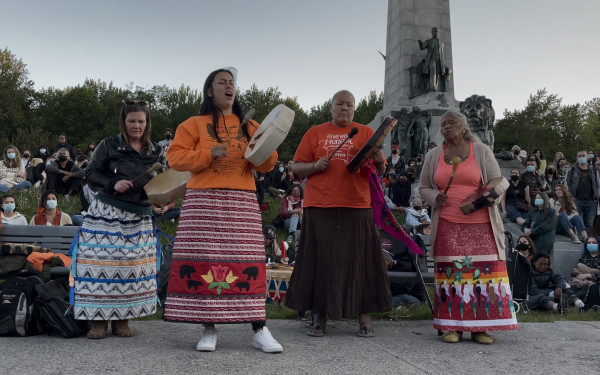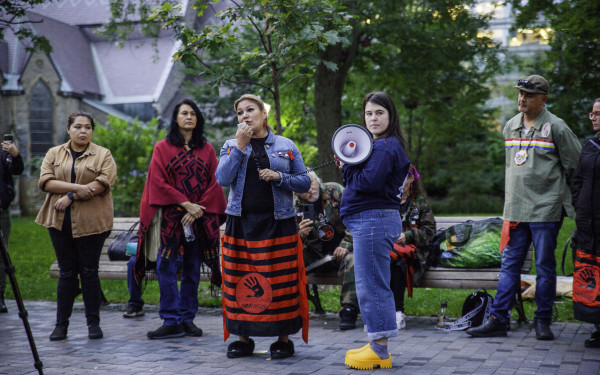The Coerced Sterilization of Indigenous Women in Canada
A People’s History of Canada Column
The signing of the Canadian Confederation in 1867 saw the birth of our great country, Canada. What many people fail to see looking back on this period is that Canada was, in fact, not all that great.
Canada, at the time of Confederation and in the years following, was a dominant Euro-Canadian society, focused on fulfilling its own manifest destiny—a term coined in the 1840s for the United States’ philosophy of spreading democracy and expanding its territory by taking over land that belonged to Indigenous populations found across the territory we’ve come to know as North America.
Only “legitimate heirs”—children born of European men and Canadian women—were seen fit to fulfill this manifest destiny, and all mixed-race heirs and illegitimate offspring of Indigenous women were considered to be “undesirable.”
This was amplified with the rise of concern for race and purity brought on by the eugenics movement of the early 20th century.
The eugenics movement sparked in 1904 in England and can be viewed from the perspective of positive and negative eugenics. While eugenics is an ongoing ethical debate even to this day, the Canadian Encyclopedia defines positive eugenics as “encouraging the procreation of individuals and groups possessing desirable characteristics and genes, strengthening the overall gene pool of society.”
Negative eugenics, however, involve discouraging or inhibiting the procreation of individuals or groups deemed undesirable by society through methods such as institutionalization, prohibiting marriage, and sterilization.
As the Euro-Canadian population searched to “better their race,” they attempted to rid themselves of those they felt to be “undesirables.” This included criminals, the mentally ill, the blind, the deaf, and the Indigenous population.
The roots of the sterilization movement begin in 1928, with the introduction of the Sexual Sterilization Act, which first passed in Alberta. This legislation allowed for, and actively promoted, the sterilization of those deemed undesirable.
While the Métis and Indigenous communities made up around 3 per cent of Alberta’s population at the time, they made up 25 per cent of the number of individuals ordered to be forcibly sterilized under the act.
In 1933, a similar act was passed in British Columbia, and tied to the residential school system.
The residential school system brought forth a multitude of horrors for the Indigenous population of Canada, as the government attempted to assimilate Indigenous people into Catholic registry.
Inmates of the residential schools, the Indigenous youth, were victims of rape, torture, medical experiments and murder. A prevalent reality for many residential school inmates was also forced or coerced sterilization.
In British Columbia, the act allowed school principals in residential schools to carry out the sterilizations, and as their legal guardian could have any Indigenous child under their charge sterilized. Often, sterilization procedures were carried out on whole groups of Indigenous children once they reached puberty.
Alberta’s Sexual Sterilization Act was under legislation for nearly 50 years, repealed only in 1972 with the newly elected government of Peter Lougheed in place.
Before the act was repealed, an astounding 2800 sterilization procedures were performed in the province of Alberta. Many individuals who were sterilized under the act were not told they were undergoing a sterilization procedure, and remained unaware of their sterilization until many years later.
These surgeries were often passed off as other surgeries and given without consent.
Often, sterilization procedures were carried out on whole groups of Indigenous children once they reached puberty.
According to witnesses and victims of the sterilization movement interviewed by Leonardo Pegoraro, a graduate student from Italy’s University of Urbino who penned a report titled “Second-rate victims: the forced sterilization of Indigenous peoples in the USA and Canada,” the government offered stipends to doctors willing to perform the surgery.
One unnamed survivor mentioned in the report, a Cowichan from Vancouver Island who was sterilized in 1952, recounts hearing that a sum of $300 would be given out to doctors for each Indigenous woman sterilized, noting that “if you were seen to be a troublemaker, you got the operation.”
She was forcefully sterilized as punishment for refusing to marry a Christian Indigenous man, instead choosing to marry a community chief.
Indigenous and Northern Affairs Canada, a government agency formerly known as Indian Affairs, told her that a doctor sterilized her following the birth of her only child.
“After I delivered my baby, Dr. Goodbrand put me under again, and when I woke up he had done the operation on me.”
“I tried to avoid him after that but the Indian Affairs people told me he was the only doctor I was allowed to see,” said the unnamed survivor.
Another witness from Pegoraro’s report said that a doctor by the name of Dr. Darby told her that INAC was paying Darby to sterilize Indigenous women, particularly if they were not church-goers.
“Hundreds of our women were sterilized by Dr. Darby, just for not going to church,” the anonymous woman said.
While the Sexual Sterilization Act was abolished, Indigenous women were still subjected to coerced sterilizations. More recently, two women have come forth claiming to have each been sterilized without their consent.
The claims date back from between 2005 and 2010. According to the CBC, an Anishinaabe woman, victim of the Sixties Scoop—a practice in which the Canadian government literally scooped Indigenous children from their families, putting them up for adoption or placing them in foster care—claims that she was asked to sign off on a tubal-ligation procedure after being administered opioids before an emergency C-section at Saskatoon’s Royal University Hospital.
She said she was also informed the procedure was reversible, which is untrue. A second woman, of the Cree nation, said she was sterilized at the same hospital despite explicitly denying consent.
The two women sterilized at the Royal University Hospital in Saskatoon have filed a lawsuit against the province of Saskatchewan, each seeking $7 million in damages, according to a CBC article published in October 2017.
A much larger suit has been launched on behalf of former patients of segregated “Indian hospitals” who experienced physical or sexual abuse or underwent coerced sterilization procedures in 29 hospitals between 1945 and the early 1980s.
The lawsuit was filed in January 2018 and amounts to a total of $1.1 billion in damages.
These sterilizations have lead to many issues in these women’s lives, including a number of physical ailments, relationship problems and depression.
The atrocities that these women faced cannot be undone, and the experience of being having the basic choice to bear children removed by one’s own government cannot be erased.
But, victims of these residential schools and coerced sterilization acts are seeking justice for themselves and fellow victims and survivors.



_600_375_s_c1.png)


_1_600_375_90_s_c1.jpeg)